30 October 2023
![]() 12 mins Read
12 mins Read
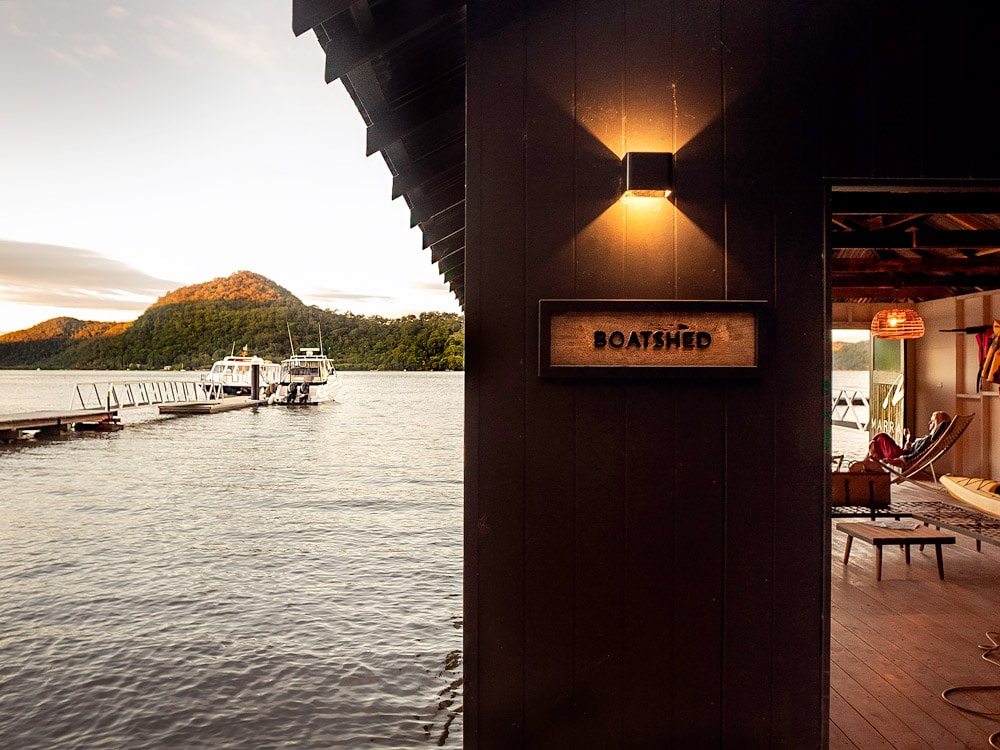
Here are the seven hidden gems that made it into positions 12 to 18 of our coveted list of 100 unique stays. Head here to read the full list and start planning your next escape.
Ever since I read The Secret Garden I’ve been drawn to whimsical gardens. If walking through a rambling, flower-filled garden is an antidote to modern ills, then staying in an old garden shed is tantamount to a course of therapy. Located in the small town of Trentham, 20 minutes east of Daylesford, the Potting Shed is a self-contained, garden-themed studio retreat on a quaint rose farm. Upon arrival I can see how much love the owners have put into this special place. What was once a working garden shed is now a cosy adults-only (but dog-friendly) retreat that honours its horticultural heritage.
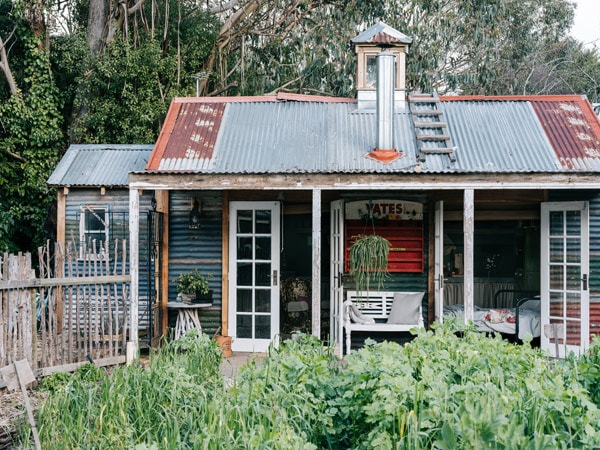
The whimsical gardens outside The Potting Shed at Acre of Roses in Trentham, Victoria.
Outside there’s a Yates display case and a productive kitchen garden. Beyond the fence there’s an acre of roses to explore, but it’s raining so I head inside as the drops beat down on the tin roof. Inside, I’m greeted by a wistful collection of vintage ephemera – still-life paintings, timeworn botanical books and retro wing-back chairs. Above, there’s a glass belltower with a bell just asking to be rung by the ropes draped over the timber beams. With a potbelly fire, fast wi-fi, commercial coffee machine, convection microwave, and fridge filled with gourmet bites, there’s no reason to leave. By night, I trade the soft embrace of the armchair for a deep slumber in a toasty bed warmed by an electric blanket.
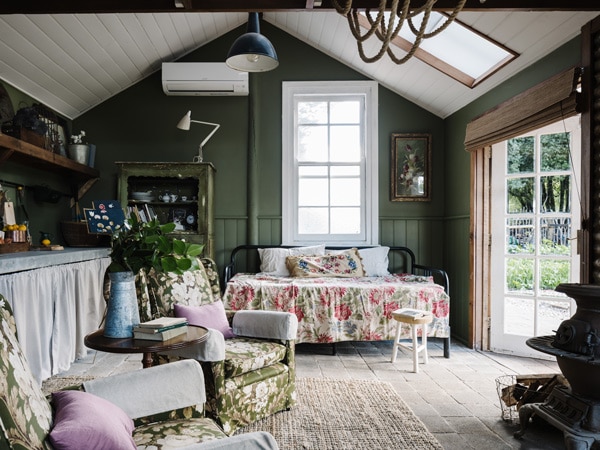
A look inside the quaint, idyllic accommodation at The Potting Shed. (Image: Marnie Hawson)
After a lingering lie-in, I graze on a complimentary continental breakfast of strawberries, muesli, yoghurt, juice, and sourdough from local artisan bakehouse RedBeard Bakery. Checking out, I realise I’ve accomplished nothing but reading, sleeping, eating, and listening to birdsong – and that’s fine by me. – Jo Stewart
No other shower I’ve been in has ever compared to the one at Faraway Bay. The corrugated iron tank – with open front and top – is best used under night’s inky cloak, when an unhampered Milky Way glows overhead. Standing naked in the dark, spring water flowing and stars beaming, I sense both awe and joy. It typifies the dedication to wonder and simplicity at this remote speck in the Kimberley, from the handcrafted dipping pool to the communal dinner table and airy bush cabins. Striking views spring from every angle: turquoise ocean, rusty red cliffs, pale beach with croc tracks to boot. Wilderness expeditions to black swimming holes, hidden rock art and the majestic King George Falls only sweeten the deal. – Fleur Bainger
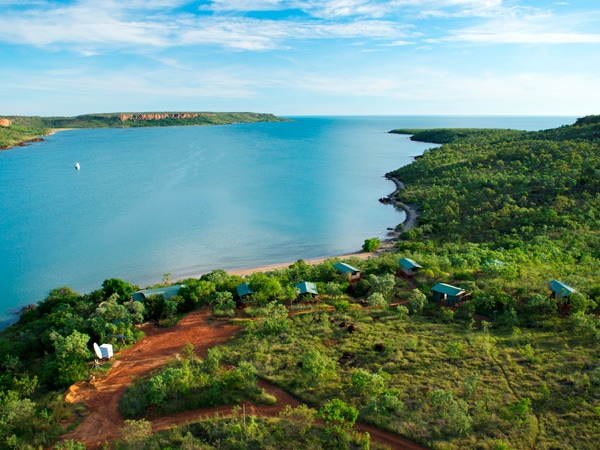
The secluded paradise of Faraway Bay is nestled on the Kimberley Coast in WA. (Image: BJK Photography)
The early morning mist has settled on the Hawkesbury River like a soft blanket and the sun streaks through the trees to warm my skin as I sit on the deck of our peninsula tent sipping a steaming cup of tea. The nearby cackle of a kookaburra cuts through the silence and I hear a slow rustling in the bushes below, likely a goanna or bush turkey. It’s nearly been a full 24 hours since my partner and I arrived by boat to Marramarra Lodge and I am soaking up the stillness of the moment, willing it to last just a little longer as the hour of our departure inches closer.
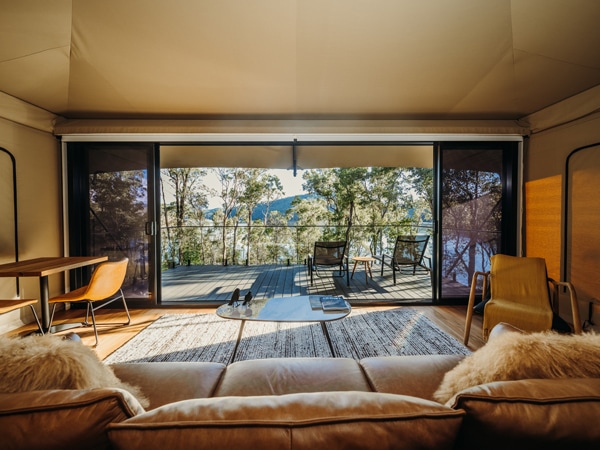
The view of the Hawkesbury River from inside the Peninsula Tents at Marramarra Lodge. (Image: Isaac Tseng)
Our glampsite, named Wirriga (meaning goanna in the language of the Dharug people), is not your traditional bell tent experience. With timber floorboards, a butter-soft leather lounge, dining area, oversized king bed, reverse cycle air conditioning and riverstone-walled bathroom, it feels more like an open-plan luxury lodge with the added bonus of canvas walls that unzip for ready-made access to the beauty of the surrounding bush. The adults-only retreat, which can only be accessed by boat, helicopter or seaplane, is located just over an hour from Sydney on Fishermans Point peninsula. The eight Peninsula Tents and six Hawkesbury Bungalows are nestled on the edge of Marramarra National Park and set over more than three hectares of land – the traditional land of the Dharug people, who have been the custodians of it for tens of thousands of years, long before European invasion. Both the peninsula and nearby Bar Island, which was once used as a meeting place between Dharug clans, are rich in Indigenous, early European and convict history.
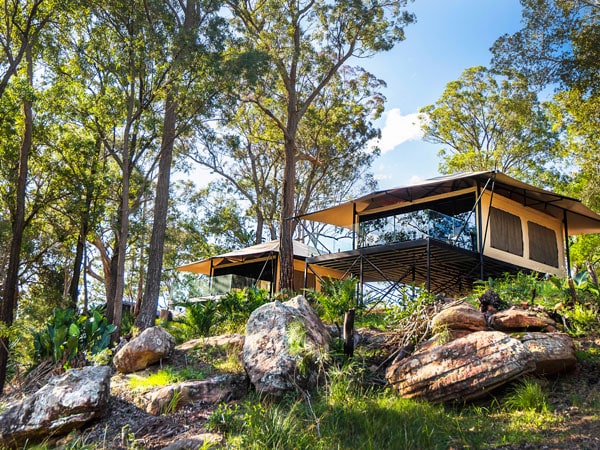
Glamping at Marramarra Lodge is not your traditional bell tent experience. (Image: Isaac Tseng)
During our arrival tour, we are pointed in the direction of a small cave on the edge of the river just beyond our deck. Inside, we find rock carvings and the remains of Aboriginal meals of periwinkles and oysters littered throughout the dirt; it offers a quiet and contemplative moment for reflection. The lodge’s dedicated team members express a deep respect and passion for Aboriginal traditions and culture – something that comes through in the way they care for and talk about Marramarra. The legacy of the Dharug people is woven into every facet of this place – from the names used to the food and experiences to the guiding operational principles that aim to preserve Marramarra’s unique origins and encourage the return of native wildlife.
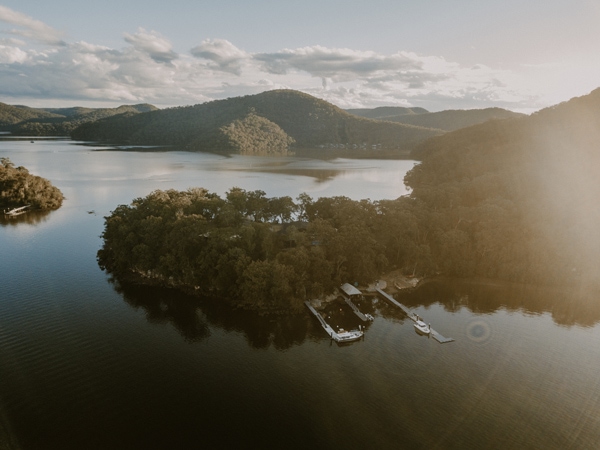
The legacy of the Dharug people is woven into every facet of a stay at Marramarra Lodge.
Just before the sun starts to set on our first day we make our way down the sandstone path to the river for an evening cruise along the Hawkesbury, complemented by oysters and sparkling wine. Our skipper points out historical sites along the riverbank as we soak up the mesmerising surroundings. The varied hues of blue of the river and sky, and on the slopes of the land on the horizon are interrupted with a dusty pink sunset that deepens to a vibrant orange as the boat slowly turns to make its way back to Marramarra for dinner.
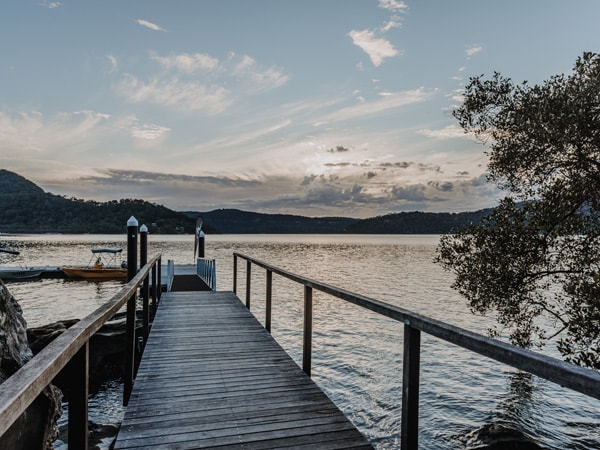
The sunset cruise departs from the picturesque Marramarra Jetty. (Image: Isaac Tseng)
Another unique aspect of Marramarra is its exclusivity. The all-inclusive stay caters to a maximum of 28 guests, which makes unwinding here alongside the river, immersed in nature, an intoxicating experience. But perhaps the most alluring aspect of all is the food and wine we are served at Budyari Restaurant. The five-course degustation features scampi, toothfish, duck, wagyu beef and a melt-in-your-mouth Basque cheesecake for dessert. Each course is perfectly paired with a mix of both local and international wines from the on-site cellar. With full stomachs, we sit around the outdoor fire pit and share stories of our day with another guest here on his babymoon. Marramarra is just the type of place you’d want to celebrate such a special occasion.
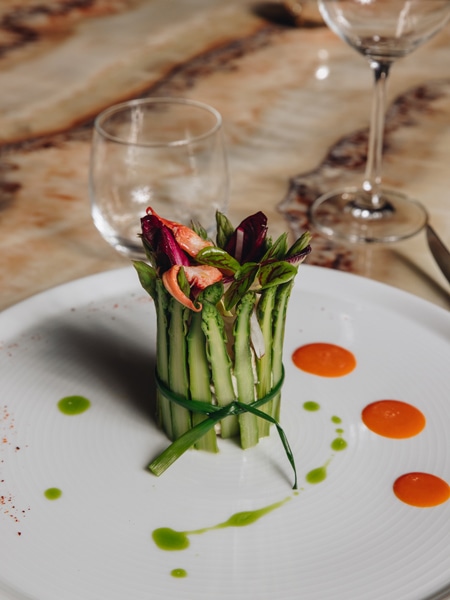
All food and wine at Budyari Restaurant is included in your stay at Marramarra Lodge.
Rain clouds roll in the next morning as we wait in the boatshed for our return transfer to Mooney Mooney. We missed the early yoga session that is held here by the water shortly after sunrise and now the hour I had tried to avoid arrives. As the boat pulls away from the jetty, the sky opens and rain falls hard and heavy. I look back as Marramarra Lodge grows smaller in the distance thinking that the rain should make it easier to leave, but strangely it only makes it harder. – Katie Carlin
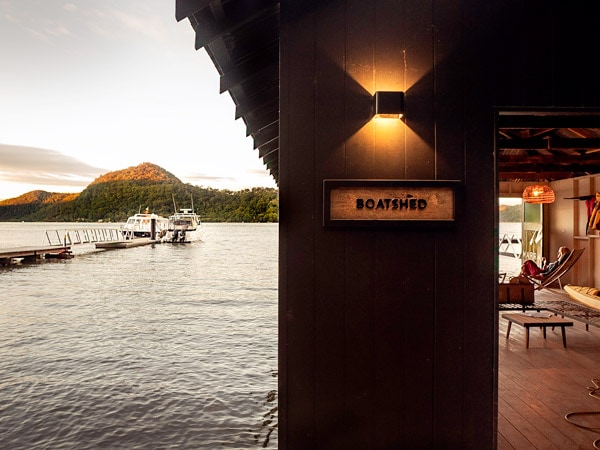
Soak up the serenity from the Boatshed at Marramarra Lodge. (Image: Torchlight Media)
The newest property from Spicers Retreats, Sangoma is the kind of intimately nature-bound hideaway where you might spend the day out on a private canyoning adventure before resting your well-worked muscles with a soak in a Philippe Starck bathtub overlooking the forest canopy. Located in a serene spot at the foothills of the Blue Mountains and blending equal parts luxury and eco cred, it promises pure escape from the everyday only an hour from Sydney.
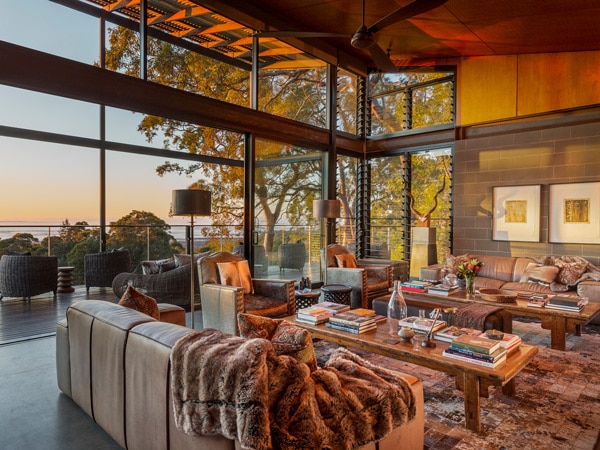
Sangoma is the newest property from Spicers Retreats. (Image: Hamilton Lund)
Ask to stay in the room that Gough Whitlam, the Duke and Duchess of Gloucester, pioneering pilot Amy Johnson and Slim Dusty all slept in before you. Hotel Corones is the fanciest pub built anywhere west of Toowoomba. Almost 100 years old, you can feel the history oozing right out of these walls; there are newer motel rooms built next door, but settle in upstairs instead in rooms that have barely changed in a century. If you’re itching for conversation, the bar downstairs (the longest bar in the southern hemisphere at the time it was built) is the place to meet Charleville’s most eccentric locals. – Craig Tansley
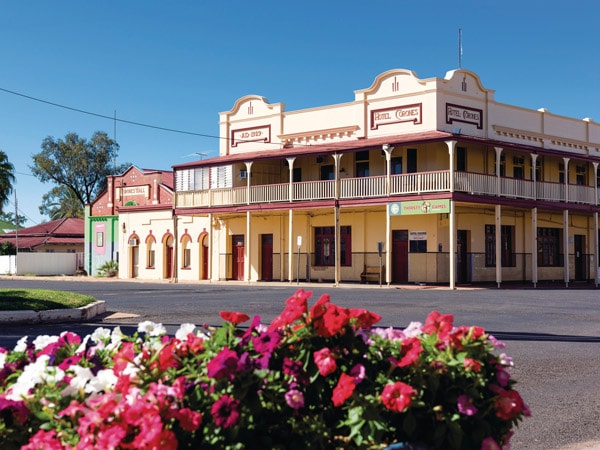
You can feel the history oozing right out of these walls(Image: Murweh Shire)
If it weren’t for owner Cathy Fitzgerald leading the way, I’d be oblivious as to where I’d be sleeping tonight. After following my GPS to this address near Eumundi, provided just the day before, I’m yet to see anything that resembles accommodation. And it all just adds to the deliciousness of the experience. We wander down a mowed track that peters out to a steeper, slightly rocky incline. I can hear water trickling around the bend. Then suddenly, in a clearing illuminated by the waning daylight, there she stands. I follow Cathy’s footsteps across the creek and marvel at the oasis she and partner Carlos Sanchez have built here.
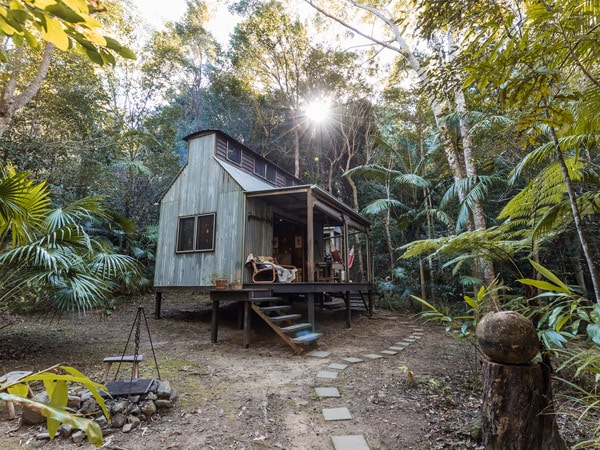
This Secret Cabin Society oasis is hidden away on the Sunshine Coast in Queensland. (Image: Krista Eppelstun for Life Unhurried)
Secret Cabin Society is exactly what it says on the label – a little-known club built for one or two at a time. It’s been crafted with consciousness for the soil, the creek, the birds. Masses of lantana were hacked away by hand, every building element carried in. I’ve stayed in off-grid places before, but this is different. It exists not just in harmony with the rainforest, but feels a living, breathing part of it.
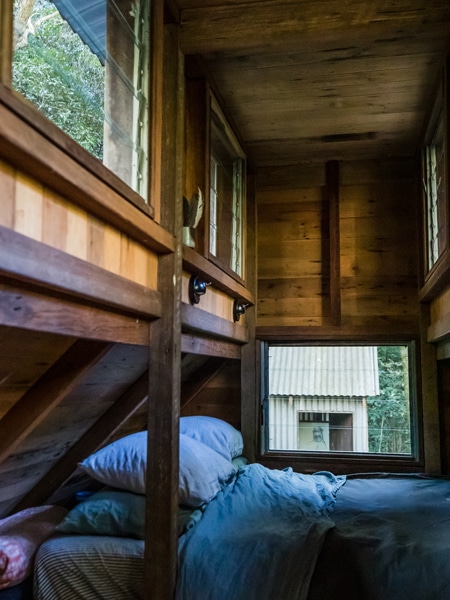
Climb the ladder inside the beautifully crafted cabin to reach your bed of an evening. (Image: Krista Eppelstun for Life Unhurried)
From outside, the cabin resembles an old tobacco kiln, clad in corrugated iron with a wooden deck where a hammock invites repose. With solar lighting inside, the space glows like that indeterminate space between sleep and dream. A writing desk sits by the wood fired heater in one corner. Beside that, two cosy armchairs, where candles drip inside lanterns above. I climb the ladder to the bed, tucked into the eaves with butter-soft linens and views into the treetops. Outside, I imagine marshmallows toasted over the campfire later; coffee brewed on the gas stove come morning. I pad barefoot across to the (composting) loo with a view that compels me to linger longer than necessary and, as the light ekes away, shower with the kiss of the rainforest on my skin. – Celeste Mitchell
No tarmac roads lead to the little settlement of Corinna. No wi-fi, phone or television leaks news of what’s going on beyond it. It’s bordered by World Heritage Takayna/Tarkine rainforest and rests on the shores of the peaceful Pieman River and, once there, it might as well be the edge of the world. For three days it will be my world.
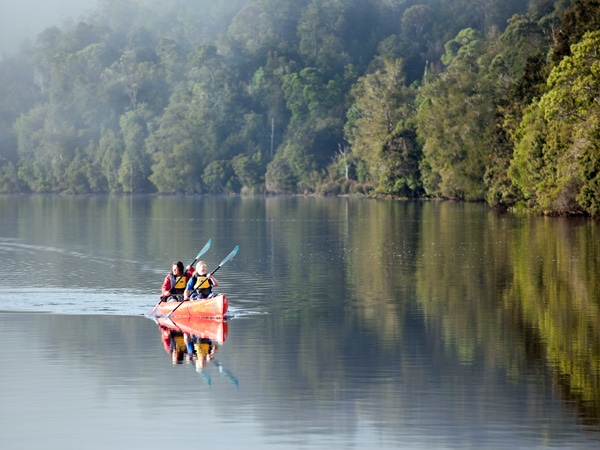
The Corinna Wilderness Experience is bordered by the World Heritage Takayna/Tarkine rainforest.
In the late 1800s, Corinna was bustling with a few thousand gold prospectors, but by 1900 the population began its decline and now the only residents are guests of Corinna Wilderness Experience where a string of timber and corrugated iron cottages have been built in the miner’s cottage style of old. They’re warm, cosy and contain all the mod cons bar a television – I prefer the dancing flames of my fireplace anyway. Central to Corinna is The Tarkine Hotel, a rustic wooden tavern serving hearty meals and Tasmanian beers and wine. In such isolation, connection with the wilderness is immediate and absolute.
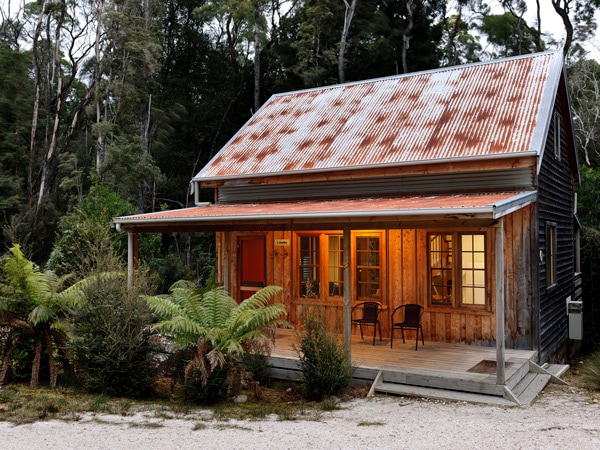
The timber and corrugated iron cottages are warm, cosy and contain all the mod cons bar a television.
The air here is some of the cleanest in the world and though I’ve seen some forests in my time, the Tarkine’s beauty is of mythical proportions. Ten walking trails meander through magnificent trees carpeted in moss and to the tussock-topped Mt Donaldson with its epic views. The Pieman River offers another perspective: a misty morning kayak on its mirror-like waters sees me glide silently past wallabies and diving azure kingfishers, while a cruise on the historic Arcadia II takes me to a remote windswept beach at Pieman Heads. Tassie’s Western Wilds feels like another place and time and, running on solar power and with plans for carbon neutrality, Corinna is doing its best to preserve what is a truly special piece of wilderness. – Laura Waters
LEAVE YOUR COMMENT